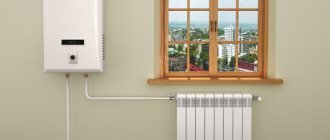Energy saving is now the most popular topic on the Internet. Of course, everyone wants to save money, especially in the current economic conditions. Calculation of heat losses plays the most important role in this case. Heat loss in the simplest sense is the amount of heat that is lost by a room, house or apartment. They are measured in Watts. Heat losses occur in the house due to the difference in external and internal air temperatures.
During the transitional and cold period of the year, the temperature on the streets drops, and the temperature difference between indoor air and outdoor air increases. And as we already mentioned, no one has canceled the Second Law of Thermodynamics, so the heat from your houses and apartments tends to leave it and warm the cold environment. To reduce these heat losses, houses are insulated in various forms, from polystyrene foam and ventilated facades to modern thermal insulation materials in the form of putty. The main task in our profession is to maintain comfortable microclimate parameters in the room. And first of all, we calculate heat losses to compensate for them.
Why do heat loss calculations?
When do they calculate heat loss in a house? Calculation of heat loss is mandatory when designing heating systems, ventilation systems, and air heating systems. Design temperatures are taken from regulatory documents. The external air temperature value corresponds to the external air temperature of the coldest five-day period. The internal temperature is taken either from the one you want or from the norms; for residential premises it is 20+-2°C.
The initial data for the calculation are: external and internal air temperature, the design of walls, floors, ceilings, the purpose of each room, and the geographic area of construction. All heat losses directly depend on the thermal resistance of the enclosing structures; the greater it is, the less heat loss.
To ensure comfortable living conditions for people in a room, it is necessary that the heat balance equation be true
Qп+ Qо+ Qс+ Qк= Qср+ Qос+ Qр+ Qpeople,
where Qп – heat loss through the floor, Qо – heat loss through the windows, Qс – heat loss through the wall, Qк – heat loss through the roof, Qср – heat gain from solar radiation, Qос – heat gain from heating systems, Qр – heat gain from appliances, Qpeople – heat gain from people .
In practice, the equation is simplified and all losses are compensated by the heating system, regardless of water or air.
Causes of heat leakage in the heating system
Heat loss also applies to heating, where heat leaks often occur for two reasons.
- A powerful radiator without a protective screen heats the street.
Heating radiator in thermal imager outside
- Not all radiators warm up completely.
Following simple rules reduces heat loss and prevents the heating system from running idle:
- A reflective screen should be installed behind each radiator.
- Before starting the heating, once a season, it is necessary to bleed the air from the system and check whether all radiators are fully warmed up. The heating system can become clogged due to accumulated air or debris (delaminations, poor-quality water). Once every 2-3 years the system must be completely flushed.
The note! When refilling, it is better to add anti-corrosion inhibitors to the water. This will support the metal elements of the system.
Heat loss calculation
Having received the initial data, designers begin calculations. Let's consider the main types of heat losses and formulas for their calculation. There are heat losses: through walls, through the floor, through windows, through the roof, through ventilation shafts and additional heat losses. Thermal resistance for all structures is calculated using the formula
Rst =1/ αв+Σ(δі / λі)+1/ αн,
where αв is the heat transfer coefficient of the inner surface of the fence, W/m2 °C; λi and δi – thermal conductivity coefficient for the material of each layer of the wall and the thickness of this layer in m; αн – heat transfer coefficient of the outer surface of the fence, W/m2·os;
Coefficients α are taken from the standards, and are different for walls and ceilings.
So, let's begin:
First of all, let's look at heat loss through the walls
The design of the walls has the greatest influence on them. Calculated using the formula: Coef. n-correction factor. Depends on the material of the structures, and n=1 is accepted if the structures are made of piece materials, and n=0.9 for the attic, n=0.75 for the basement floor.
Example: Let's consider heat loss through a 510 mm brick wall with 100 mm mineral wool insulation and a 30 mm decorative finishing ball. Internal air temperature 22ºС, external -20ºС. Let it be 3 m high and 4 m long. The room has one external wall, placement to the South, the area is not windy, without external doors. First you need to know the thermal conductivity coefficients of these materials. From the table above we find out: λk =0.58 W/mºC, λut =0.064 W/mºC, λsht =0.76 W/mºC. After this, the thermal resistance of the enclosing structure is calculated:
Rst=1/ 23 +0.51/0.58+0.1/0.064+0.03/0.76+ 1/ 8.6 = 2.64 m2 ºС/W.
For our area, such resistance is not enough and the house needs to be better insulated. But that’s not about that now. Heat loss calculation:
Q=1/R·FΔt·n·β=1/2.64·12·42·1·(10/100+1)=210W.
ß is additional heat loss. Next, we will describe their meaning and it will become clear where the number 10 comes from and why divide by 100.
Next comes heat loss through the windows
Everything is simpler here. Calculation of thermal resistance is not necessary, because it is already indicated in the passport of modern windows. Heat loss through windows is calculated according to the same scheme as through walls. For example, let's calculate the losses through energy-saving windows with a thermal resistance of Ro = 0.87 (m2°C/W) of size 1.5 * 1.5 and oriented to the North. Q=1/0.87·2.25·42·1·(15/100+1)=125 W.
Heat loss through ceilings includes heat removal through roof and floor coverings. This is mainly done for apartments where both the floor and ceiling are reinforced concrete slabs. On the top floor only losses through the ceiling are taken into account, and on the first floor only through the basement floor. This is due to the fact that the same air temperature is assumed in all apartments, and heat transfer from apartment to apartment is not taken into account. Recent studies have shown that large heat losses occur through non-insulated junctions between floors and enclosing structures.
The definition of heat leakage through a ceiling is the same as for a wall, but additional heat loss is not taken into account. The coefficient α is taken differently: α in = 8.7 W/(m 2 K) α in = 6 W/(m 2 K), the temperature difference is also the same, because in the basement or in a covered attic the temperature is taken within 4-6ºС. We will not describe the calculation of thermal resistance for the ceiling, because it is determined by the same formula Rst = 1/ αв + Σ ( δі / λі ) + 1/ α. Let's take a ceiling with a resistance of 4.95 and take the air in the attic +4ºС, the ceiling area is 3x4 m, inside 22ºС. Substitute into the formula and get: Q=1/R·FΔt·n·β=1/4.95·12·18·0.9= 40 W.
Calculation of heat loss through the floor on the ground
It is a little more complicated than through the ceiling. Heat losses are calculated by zone. A zone is a strip of floor 2 m wide, parallel to the outer wall. The first zone is located directly next to the wall, where the most heat loss occurs. It will be followed by the second and other zones, up to the center of the floor. For each zone, its own heat transfer coefficient is calculated. To simplify, the concept of resistivity is introduced: for the first zone R1=2.15 (m2°C/W), for the second R2=4.3 (m2°C/W), for the third R3=8.6 (m2°C/W) W)
Example There is a room in which the floor is on the ground, the floor size is 6x8 m. The temperatures are still the same. First, let's divide the floor into zones. We got two of them. Find the area of each zone. For us it is 20 m2 for the first zone and 8 m2 for the second. Then we set the conditional resistances R1=2.15 (m2°C/W), R2=4.3 (m2°C/W), substitute into the formula: Q=(F1/R1+F2/R2+F3/R3)( tout - tin) n=(20/2.15+8/4.3) 42 1= 470 W.
Additional heat loss
They are taken into account only for walls and windows, that is, structures that are in direct contact with the environment. There are four types of additional heat loss: orientation, windiness, the number of walls and the presence of external doors. They are expressed as a percentage and subsequently converted into an additional heat loss coefficient. If the room is oriented to the North, East, North-East, North-West, additional heat loss is 10%, when to the South, West, South-West, South-East, 5% is added. If the building is located in a windy area, another 10% of heat loss is added, and when in an area protected from the winds, only 5%. If the room has two external walls, then additional losses are 5%, when there is only one, there are no additional losses. If there is a door in the external wall, you can calculate the loss through it, but it is easier to add 60% if the doors are triple, 80% if the doors are double and 95% if they are single. For example: A room has two external walls, located in a windy area, one wall faces South, the other faces North, there are no doors. Then the additional losses are 10% + 5% for orientation + 10% for wind + 5% since there are two walls. And that 30%, in order to add them to the main heat losses, needs to be converted into a coefficient β = 30% + 100% = 30/100 + 1 = 1.3 and substituted into the general formula.
Heat loss for ventilation
They are not taken into account if air heating is being designed or a ventilation unit with air heating is used, since the air entering the room is already warm and no heat is wasted on heating it. But if the installation is not heated, it is necessary to take into account the heat consumption for heating the incoming air. The simplified formula looks like this:
Q=0.337·V·Δt
where V is the room in m3, Δt is the difference between external and external temperatures.
The sum of all heat losses constitutes the total losses of the room.
Junction points of building structures
The compounds disrupt the integrity of the materials. Therefore, corners, joints and abutments are so vulnerable to cold and moisture. The joints of concrete panels become damp first, and fungus and mold appear there. The temperature difference between the corner of the room (the junction of the structures) and the main wall can range from 5-6 degrees, to sub-zero temperatures and condensation inside the corner.
Corner of room window on thermal imager
Clue! At the sites of such connections, craftsmen recommend making an increased layer of insulation on the outside.
Heat often escapes through the interfloor ceiling when the slab is laid across the entire thickness of the wall and its edges face the street. Here the heat loss of both the first and second floors increases. Drafts form. Again, if there is a heated floor on the second floor, the external insulation should be designed for this.
Calculation of heat losses in Excel
The process of calculating heat losses at home takes quite a lot of time, so we created a template for ourselves in Excel with which we make calculations. We decided to share it with you and you can use it by following the link. Here we will write out the instructions for use.
Step 1
Follow the link and open the program file. You will see a table like this:
Step 2
You need to fill in the initial data: room number (if you need it), its name and temperature inside, the name of the enclosing structures and their orientation, the dimensions of the structures. You will see that the area counts itself. If you want to subtract the window area from the walls, you need to adjust the formulas, since we do not know where your windows will be recorded. Our space is being taken away. You also need to fill in the heat transfer coefficient 1/R, temperature difference and correction factor. Unfortunately, they are filled out manually. In the example, we have an office with three external walls; one wall has two windows, another has no windows, and the third has one window. The wall structure will be as in the example where we calculated R, eat k=1/R=1/2.64=0.38. Let the floor be on the ground and divide it into zones; we have two of them and calculate the losses for two zones, then k1 = 1/2.15 = 0.47, k2 = 1/4.3 = 0.23. Let the windows be energy-saving Ro = 0.87 (m2°C/W), then k = 1/0.87 = 1.14.
The picture shows that the amount of heat loss is already visible.
Step 3
Unfortunately, additional losses are also filled in manually. You need to enter them as a percentage; the program itself will convert them into a coefficient in the formula. And so, for our example: Walls 3 means +5% heat loss to each wall, the terrain is not spindle therefore +5% to each window and wall, Orientation to the South +5% for structures, to the North and East +10%. There are no external doors, therefore 0, but if there were, the percentages would only be added up to the wall in which there is a door. We remind you that additional heat losses do not apply to the floor or ceiling.
As you can see, the loss of premises has increased. If you already have warm air entering the room, this is the last step. The number written in column Q is your desired heat loss of the room. And this procedure must be carried out for all other premises.
Step 4
In our case, the air is not heated, and in order to calculate the total heat loss, we need to enter the area of our room 18 m2 in column R, and its height 3 m in column S.
This program significantly speeds up and simplifies calculations, even despite the large number of manually entered elements. She helped us more than once. We hope it will become a helper for you too!
Heat loss from the foundation
Concrete is the predominant material in foundation construction. Its high thermal conductivity and direct contact with the ground result in up to 20% heat loss along the entire perimeter of the building. The foundation conducts heat particularly strongly from the basement and improperly installed heated floors on the first floor.
Heat loss through the foundation
Heat loss is also increased by excess moisture that is not removed from the house. It destroys the foundation, creating openings for the cold. Many thermal insulation materials are also sensitive to humidity. For example, mineral wool, which is often transferred to the foundation from general insulation. It is easily damaged by moisture and therefore requires a dense protective frame. Expanded clay also loses its thermal insulation properties on constantly wet soil. Its structure creates an air cushion and well compensates for ground pressure during freezing, but the constant presence of moisture minimizes the beneficial properties of expanded clay in insulation. That is why the creation of working drainage is a prerequisite for the long life of the foundation and heat conservation.
This also includes in importance the waterproofing protection of the base, as well as a multi-layer blind area, at least a meter wide. With a columnar foundation or heaving soil, the blind area around the perimeter is insulated to protect the soil at the base of the house from freezing. The blind area is insulated with expanded clay, sheets of expanded polystyrene or polystyrene.
It is better to choose sheet materials for foundation insulation with a groove connection, and treat it with a special silicone compound. The tightness of the locks blocks access to the cold and guarantees continuous protection of the foundation. In this matter, seamless spraying of polyurethane foam has an undeniable advantage. In addition, the material is elastic and does not crack when the soil heaves.
For all types of foundations, you can use the developed insulation schemes. An exception may be a foundation on piles due to its design. Here, when processing the grillage, it is important to take into account the heaving of the soil and choose a technology that does not destroy the piles. This is a complex calculation. Practice shows that a house on stilts is protected from the cold by a properly insulated floor on the first floor.
Attention! If the house has a basement and it often floods, then this must be taken into account when insulating the foundation. Since the insulation/insulator in this case will clog moisture in the foundation and destroy it. Accordingly, heat will be lost even more. The first thing that needs to be resolved is the flooding issue.
Results for insulating a private house
Insulating a house is very beneficial , and in most cases it is even necessary, because... this is due to a large number of advantages over non-insulated houses, and allows you to save your family budget.
Having carried out external and internal insulation of the house, your private home will become like a thermos. Heat will not escape from it in winter and heat will not come in in summer, and all costs for complete insulation of the facade and roof, basement and foundation will be recouped within one heating season.
For the optimal choice of insulation for your home , we recommend that you read our article: Main types of insulation for your home, which discusses in detail the main types of insulation used to insulate a private home outside and inside, their pros and cons.
Thermal calculator
Using this calculator, you can quickly calculate the amount of heat required for each individual living space.
To calculate heat loss, enter the indicators of the desired room in the specified fields and drop-down lists.
The calculation occurs automatically.
The resulting readings of the heat loss of the room and the required heating output of the heating system boiler are displayed in the right part of the calculator.
By comparing the performance in different rooms, it is easy to determine the efficiency of heating systems.
Optimal indicators in some rooms and insufficient indicators in others will help you adjust the operation of heating devices correctly, and will also show the need for insulation or replacement of windows.
Under the concept of "residential"
This includes premises where people live all year round. Country houses are not considered “residential”, since they are heated “occasionally”.
Heat loss through the roof
Heat initially tends to the top of the house, making the roof one of the most vulnerable elements. It accounts for up to 25% of all heat loss.
A cold attic or residential attic is insulated equally tightly. The main heat losses occur at the junctions of materials, it does not matter whether it is insulation or structural elements. Thus, an often overlooked bridge of cold is the boundary of the walls with the transition to the roof. It is advisable to treat this area together with the Mauerlat.
Border of walls with transition to roof
Basic insulation also has its own nuances, related more to the materials used. For example:
- Mineral wool insulation should be protected from moisture and it is advisable to change it every 10 to 15 years. Over time, it cakes and begins to let in heat.
- Ecowool, which has excellent “breathable” insulation properties, should not be located near hot springs - when heated, it smolders, leaving holes in the insulation.
- When using polyurethane foam, it is necessary to arrange ventilation. The material is vapor-proof, and it is better not to accumulate excess moisture under the roof - other materials are damaged and a gap appears in the insulation.
- Plates in multi-layer thermal insulation must be laid in a checkerboard pattern and must adhere closely to the elements.
Practice! In overhead structures, any breach can remove a lot of expensive heat. Here it is important to place emphasis on dense and continuous insulation.










